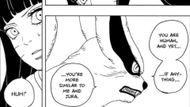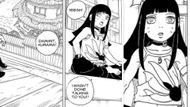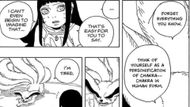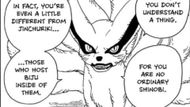The release of Boruto Two Blue Vortex chapter 25 has changed everything. When the series first began, many fans were unsure of how the new era would treat characters like Himawari Uzumaki. After all, the daughter of Naruto and Hinata had largely been a background presence in the manga series. Cute, charming, but narratively sidelined.
This chapter confirmed something game-changing: Himawari is not a traditional jinchūriki. Instead, she is something new, something unprecedented, a “human bijū.” Kurama himself states that she is closer to a tailed beast than to an ordinary host. At just 13 years old, she’s being compared to the strongest entities in the franchise.
This makes her one of the most exciting and important female characters we’ve ever seen in Naruto and Boruto. We all remember the decades-long journey of Naruto and Kurama’s relationship.

But Himawari is different. Kurama makes it clear that she and he are not in a host-and-beast relationship. They are fused at a conceptual level; it means that their chakras, even their souls, are intertwined.
In a way, she’s the true reincarnation of the Nine-Tails, not through sealing, but through rebirth. That alone elevates her beyond every jinchūriki we’ve seen before. That is why Himawari might be the true bridge between the old world and the new.
A Human Bijū: What this means for power scaling

Kurama’s statement in Boruto Two Blue Vortex chapter 25, that Himawari is closer to a bijū than a human, cannot be understated. In practical terms, this means she can access power beyond anything Naruto or other hosts ever achieved.
This opens the door to terrifying potential. Some fans speculate she could access a permanent Baryon Mode, not the sacrificial technique Naruto used, but a stable form of fused chakra that doesn’t burn out. If true, Himawari would already stand shoulder to shoulder with the top fighters of her generation.
Female representation done right

One of the long-standing criticisms of Naruto has been its treatment of female characters. Himawari changes that narrative. She isn’t strong because of a man and isn’t defined by romance. She isn’t waiting in the wings for character scraps. Instead, she’s inheriting the mantle of a being as iconic as Kurama, reshaping shinobi history in the process.
That’s monumental. For once, a female character in this franchise is positioned not as backup, but as a generational icon. When Kurama says Himawari is “closer to bijū than human,” it’s also the story saying: She matters on a level no kunoichi ever has before.
Why did Kurama display new information in the Boruto Two Blue Vortex chapter 25?

A lingering question is why Kurama never mentioned this bond earlier. Why wait until Boruto Two Blue Vortex chapter 25? The answer might be both narrative and thematic. Kurama has always been cryptic, revealing information only when the time was right.
By reintroducing himself inside Himawari, Kurama chose the moment in Boruto Two Blue Vortex chapter 25 as the new generation needed a shakeup. Naruto is gone. Boruto is burdened with Karma. Kawaki is consumed by obsession. It’s brilliant storytelling.
Moreover, by holding back the reveal, Ikemoto ensured that Himawari’s moment felt like a shockwave. She isn’t just growing into relevance; she was always destined for it.
Final thoughts
Boruto Two Blue Vortex chapter 25 didn’t just give Himawari a power-up. It cemented her as a generational character. And more importantly, she does so as a 13-year-old girl stepping into her own story, not as someone’s love interest, not as a supporting role, but as a central, unstoppable force in the shinobi world. As far as we know, Chapter 25 could mark the start of the Himawari Era.
